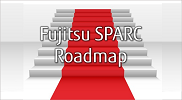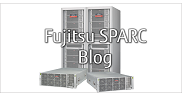Archived content
NOTE: this is an archived page and the content is likely to be out of date.
Interview with Takato Noda, Corporate Vice President of Fujitsu

A Mission Critical Server that Only a Company with Processor Expertise Could Develop - That's the Fujitsu M10.
One year ago in September, 2012, the Fujitsu SPARC Server range "Fujitsu M10" was introduced for the first time at Oracle OpenWorld 2012, held in San Francisco. The Fujitsu M10 processor is the SPARC64 X, which was recently developed by Fujitsu, and the OS is Oracle Solaris. This is currently the only UNIX server made in Japan.
However, no one can deny that the hardware industry is facing difficult business challenges, not only with UNIX servers, but everything from mainframes and x86 servers to client PCs. As one of the few hardware vendors left in the world that start production from the processor, how is Fujitsu developing its UNIX server business? We spoke with Takato Noda, the Corporate Vice President and Head of Enterprise Server Business Unit at Fujitsu. Takato Noda assumes direct command at the server development level.
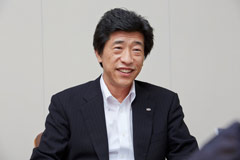 Takato Noda, Corporate Vice PresidentHead of Enterprise Server Business UnitFujitsu Limited Takato Noda, Corporate Vice PresidentHead of Enterprise Server Business UnitFujitsu Limited |
Takato Noda - responsible for development of Fujitsu's UNIX servers.Since entering Fujitsu, Takato Noda has been actively involved with processor and memory system development, and supervision of hardware development for x86 and UNIX servers. With his technical prowess watching over the complete system creation process, and his uncompromising development style, Takato Noda leads Fujitsu in creating world leading servers. "An energetic technical group with advanced developmental prowess." is his dictum for driving Fujitsu's hardware development team. |
A server developed for Mission Critical Systems and Big Data
One year has passed since the Fujitsu M10 was introduced at last year's Oracle OpenWorld, and approximately eight months since it began shipping at the end of 2012. What has the response been like from the market and from customers?
- We've received excellent reviews from customers all around the world, primarily in the financial and manufacturing industries. In particular, we have seen a distinct trend of customers with old SPARC servers, or a large amount of servers, lean towards virtualization and consolidation solutions, and it seems Fujitsu M10 is a perfect match to meet the needs of those customers. In addition there's a strong belief amongst customers of Fujitsu M10 that they "don't want to trade off reliability for performance." I'm confident that we're responding well to those needs.
Have Fujitsu been able to enter into industries that have not been able to reach before with the Fujitsu M10?
- Fujitsu M10 has been generally implemented in organizations that perform HPC (High Performance Computing) or in organizations that perform financial engineering simulations. However, I expect that with the increase of organizations handling Big Data, Fujitsu M10 will spread across many more industries.
You mentioned that there is an increase in customers oriented towards virtualization and consolidation. Do you mean that, specifically, customers are consolidating older versions of Oracle Solaris and old applications running on that OS?
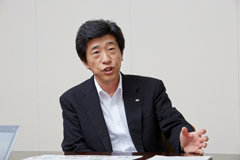
- People often say that the history of computing repeats in cycles of centralization and decentralization. You can certainly say that currently, we are in a period of centralization. Demand to integrate disparate data from all over the world into one location is extremely high. However, the current trend towards centralization is substantially different to that which has occurred in previous generations. The trend known as Big Data that drives current ICT is not just a fad, but rather high demand from customers saying, "I want to collect data in one location, and analyze it. I want to arrange a Data Warehouse (DWH) or Business Intelligence (BI) environment to do that." Customers don't want to just consolidate old servers; they want to use the information collected by the business, for the business. Fujitsu M10 is a server that can ensure the database delivers maximum performance, to sufficiently meet customer needs in using and analyzing the data collected by the business.
Why do you believe Fujitsu M10 is best suited for database consolidation and Big Data analysis?
- Fujitsu M10 was originally designed based the "Software on Chip" concept, where we thought, "To make a database run faster, it's best to allocate the data near the processor. Actually, wouldn't it be better to just implement a database processing function on the processor?" In addition to our unique liquid cooling technology, by directly connecting sixteen DIMMs (memory) to a single processor, we dramatically increase the memory access performance. You could say that only a vendor that starts production from the processor (SPARC64 X) has the capability to develop such an advanced server.
One more concept we can't leave out when we talk about the Fujitsu M10 is the "Building Block" function, which allows for dynamic scaling. Quite a few customers are hesitant to transfer to or install a large scale system from the start, they would rather, with the consideration of cost, workloads, and the amount of data, "start small and grow large". To meet the needs of those customers', Fujitsu M10-4S allows customers to scale up (increase the number of CPUs) and scale out (increase the number of devices) as their business grows. Because you can directly connect eight building blocks in a single rack, and a maximum of sixteen building blocks in total (two racks), you can expand the system up to 64 CPUs and 1024 cores. This equips the server with the world's largest amount of memory in a single machine.
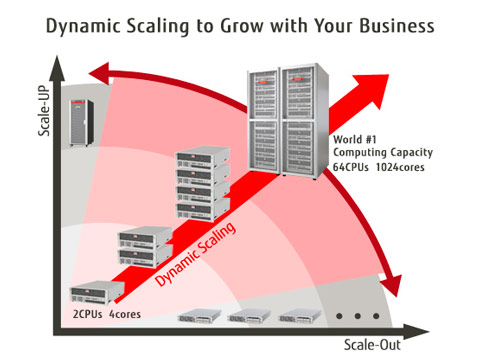
Fujitsu M10-4S is a 4-socket 4RU rack-mount server, although I understand it was originally designed as a 6RU server. I heard the change was because you insisted, "Go with 4RU," and pressed forward.
- Who did you hear that from? (laughs) However, it's true I pushed for the 4RU as I believe it operates better within our customer's data center than the 6RU does.. Customers buy just one Fujitsu M10-4S at first to use as a development machine, but then want to expand it as it is, and make it a production machine. We have to make that transition easy. For our customers, hardware needs to grow with their changing business environment.
Do you mean that Fujitsu M10 is a server that evolves with your customer's business?
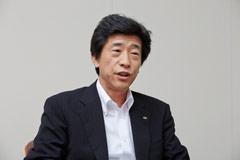
- That's right. It evolves with our customer's business, and we use their feedback for our future developments. I believe Fujitsu's UNIX servers have been, and will continue to be hardware that evolves in that way.
The advantages of Fujitsu M10 can appeal to organizations all around the world
There are several products from competing companies rivaling Fujitsu M10 in the big data and mission critical fields. How do you perceive the difference between those products and yours?
- Speaking functionality, the "Building Block" I mentioned earlier is a big advantage. Our product is the only server where you can scale up to 64 CPUs vertically, or horizontally.
There are also three technical points we were particular about when developing Fujitsu M10. Those are large-capacity memory, low latency through high-speed connections, and Software on Chip. These three are related to the Building Block architecture, and we definitely plan on enhancing them in the future.
Something else I'd like to emphasize Is that we placed extreme importance on Fujitsu M10 being "a server that doesn't break down", and I am strongly confident that it will not lose to any competitor in relation to RAS (Reliability, Availability, Serviceability). Mission critical machines must not break down easily, and of course the same is true with big data.
That idea is quite different from some big data processing solutions like Hadoop, where a lot of standard x86 servers are lined up next to each other and big data is distributed and processed. Hadoop was designed on the premise that even if one or two servers broke down, that processing could continue on a different server.
- This may be something that only Fujitsu is particular about, because we develop processors. Fujitsu M10 is a unique server with a unique processor. We can't allow a situation where the machine breaks down easily. Of course, any hardware can break down, however we spare no effort to continue reducing that probability. It's also very important that, should a machine break, the data isn't damaged, and methods to quickly recover the machine are prepared. To take it a step further, we equipped a checker function for maintaining reliability even if performance is sacrificed. Our development philosophy of "never cutting corners" regarding RAS, is a more valuable difference, especially in this big data age where customers consolidate and analyze databases and employ that big data.
In terms of difference, how do you intend to differentiate your machine from previous SPARC servers?
- I suppose there are three differences: the database performance powered by Software on Chip, the expandability through Building Block architecture, and reliability of the hardware, starting with the processor. The Fujitsu M10's processor is equipped with iron-tight RAS features inherited from mainframe technology, and this is well-received by customers who require highly-reliable databases. In the coming in-memory database age, large amounts of data will be put on the memory, so server reliability will become more and more important. As I look at the market, I believe Fujitsu M10 is already being used in sectors that have higher mission critical demand.
Both technology and humanity develop because we have competition.
Fujitsu has been making real progress in global market development these past couple years, and understand you have been actively pushing Fujitsu M10 in the foreign market. What points is the difference between your strategies in the overseas markets and in the Japanese market?
- Well actually, I don't really draw those lines in business. Globalization is something we've put effort into for a long time, although the appeal for Fujitsu M10 are not that different between Japan and other regions. Of course each area has its own distinctive features, but we advance our business in any market without changing the basic approach of – Fujitsu M10 will protect your investments.
You're fighting on a global scale. How do you view the status quo of the hardware market, which is gradually shrinking?
- What is making the hardware market difficult? Honestly, I believe it's because the development of hardware cannot keep up with the times. Actually, hardware has room to advance. In terms of performance, it should be able to become even faster. This is related to what we talked about before, but don't you think that hardware needs to add new functions to match the changing times? The hardware industry needs the power to bring about innovation while looking at the reality of business.
How can Fujitsu overcome these issues?
- Fujitsu is a technology company. Even in the global market, we show that we are an "engineering company" on all fronts. For example, the SPARC64 is at the center of the supercomputer, K computer. The speed-enhancing structure cultivated in the K computer was inherited by the SPARC64 X, and equipped in the Fujitsu M10. And above all, Fujitsu is also a development vendor of mainframes. Fujitsu has this kind of history and heritage in technology. This isn't something that can be gained overnight. Using that collected technology experience, I hope we can continue to perform developments that will position us as an engineering leader.
Speaking of the K computer, it was once the world's best supercomputer. I've heard that the Fujitsu M10 has also set a number of world records in benchmarks.
- It's set world records in many performance benchmarks, such as the Java application benchmark and an SAP ERP application benchmark. It also boasts excellent processing performance compared to other servers in Business Intelligence (BI) application such as SAS. Eventually, any record will be broken, and the fight against competition will never end. I believe that competition itself is absolutely necessary for the market, and to say it on a grander scale, for humanity. Always move forward, aim for a place higher than where you are now – If you don't have the height of that kind of vision, you won't survive in the Japanese market or in the global market.
In that sense, if you look again at the global market, I think that the USA is very aggressive. Americans work and study extremely hard and They have a big appetite for competition too. Even customers in that market have amazing power – they can construct advanced systems themselves. You could say it's the market I want to make Fujitsu M10 succeed in the most.
I think that to face tough competition, communication within a team becomes very important. Could you please tell us where you focus your efforts as an on-site leader?
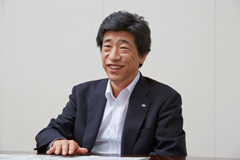
- Fujitsu develops servers looking at the ICT environment five or ten years from now, and where our customers' are headed. Fujitsu M10's idea of Dynamic Scaling also comes from there. As projects go on for a long time, developers tend to forget what they are working on. I believe in the importance of the three "actuals": actual place, actual thing, and actual situation. I make an effort to always be aware of these things. What are we making? Who are we making it for? What's the current situation? Because if you don't understand the current situation, improvement and innovation are impossible.
The Fujitsu M10 is a server for mission critical systems. For it to be mission critical, it needs to be a product that makes us (the makers), our customers (the users), and society as a whole happier. We're continuing to make products like that, – with that kind of pride and excitement, I want to continue development as a hardware vendor that starts production from the processor.
